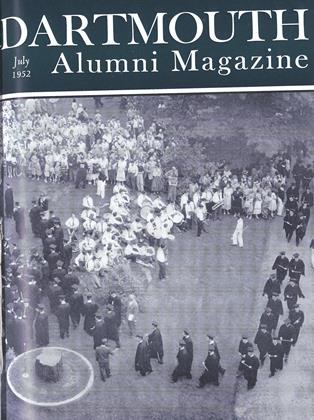, by Henry F. Lenning'37- Martinus J. Nijhoff, The Hague, 1951;143 pp.; 21 guilders ($6.00).
For a brief span, from 1895 to 1905, ArtNouveau flourished in Western Europe. Its life was short, it disintegrated rapidly but it left a permanent mark on architectural planning. To most of us it means asymmetrically curving lines with possibly flowers bobbing at the end. It is high time that we knew that it is the source of the International Style which developed into our own mid-twentieth-century modern. In its pure and early form, simplicity and functional efficiency prevailed, seeking plenty of light, air and a free flowing house plan. Architecture and interior decoration went hand in hand. The theory included a dynamic line which developed rather than decorated form.
It is depressing to see how quickly these sound principles were submerged by a welter of frivolous trimmings and complicated, absurd facades were imposed on conventional interiors. As the style collapsed it lacked dignity and comfort. Yet it was not a total loss for it carried the Arts-and-Crafts movement of William Morris, with its emotional appeal, through Van de Velde's intellectual approach (he was the Art Nouveau leader) to the contemporary combination which has so far managed to retain the essential simplicity necessary for an enduring style. Without the Art Nouveau, the Morris movement would probably have been a dead end.
The book is logically arranged, well illustrated and has a complete set of notes and bibliography. It is the result of careful and competent research. One feels the lack of a few illustrated pages giving a concise summary of the characteristic features of the style, but its evolution and decline are well explained, and buttressed by many quotations from the artists and critics of the time. As the first comprehensive study of this important movement in early modern art, the book is an especially valuable contribution to the literature of the field.
 View Full Issue
View Full Issue
More From This Issue
-
 Article
ArticleThe Fifty-Year Address
July 1952 By E. BRADLEE WATSON '02 -
 Article
ArticleThe 1952 Commencement
July 1952 -
 Article
ArticleBaccalaureate Address
July 1952 By SIR OLIVER S. FRANKS -
 Article
ArticleDartmouth Awards Mine Honorary Degrees
July 1952 -
 Class Notes
Class NotesThe Big 25th for 1927
July 1952 By DOANE ARNOLD '27 -
 Class Notes
Class NotesA Glowing 190 7 Report
July 1952 By H. RICHARDSON LANE '07
Maude D. French
-
 Books
BooksBARTHOLOMEW AND THE OOBLECK
January 1950 By Maude D. French -
 Books
BooksHORTON HEARS A WHO!
December 1954 By MAUDE D. FRENCH -
 Books
BooksON BEYOND ZEBRA!
December 1955 By MAUDE D. FRENCH -
 Books
BooksYERTLE THE TURTLE AND OTHER STORIES.
OCTOBER 1958 By MAUDE D. FRENCH -
 Books
BooksHAPPY BIRTHDAY TO YOU!
November 1959 By MAUDE D. FRENCH -
 Books
BooksTEN APPLES UP ON TOP!
June 1961 By MAUDE D. FRENCH
Books
-
 Books
BooksShelflife
Jan/Feb 2009 -
 Books
BooksINTRODUCTION TO MENTAL HYGIENE
January, 1931 By C. N. Allen -
 Books
BooksFreezing Points of Anti-coagulant
February 1936 By David I. Hitchcock '15 -
 Books
BooksThe New Right
November 1979 By Laurence I. Radway -
 Books
BooksTHE CURRICULUM OF THE COMMON SCHOOL
June 1941 By Ralph A. Burns -
 Books
BooksMAKE FREE: THE STORY OF THE UNDERGROUND RAILROAD.
OCTOBER 1958 By RICHARD W. MORIN '24

